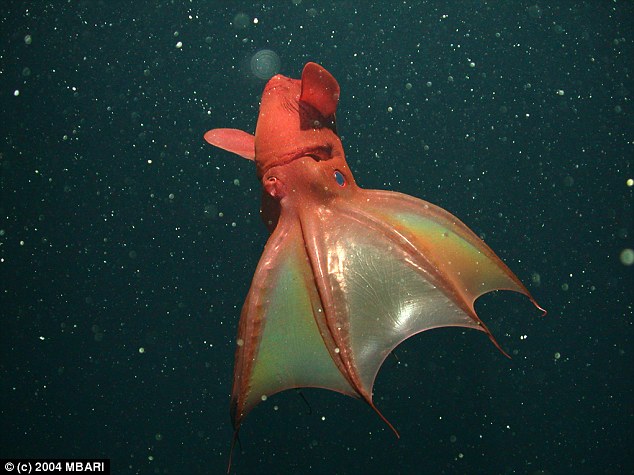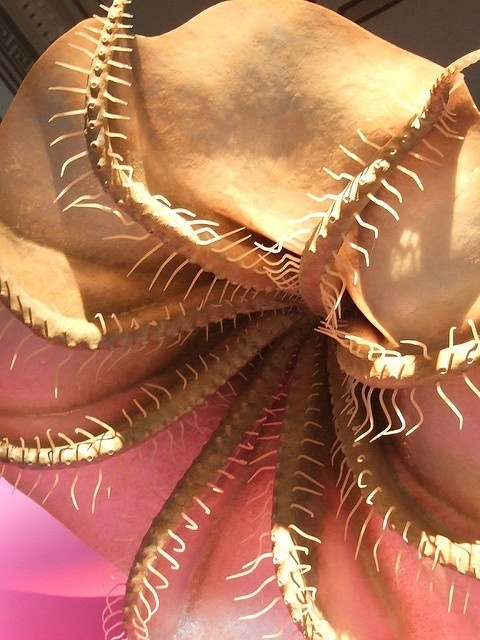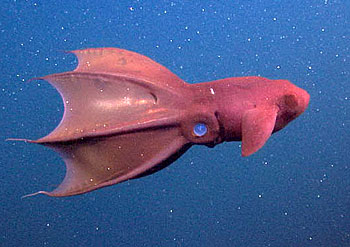Vampire Squid Facts
A-Z Collection of Cool Animals Challenge
V is for Vampire Squid
The vampire squid (Vampyroteuthis infernalis, lit. “vampire squid of Hell”), is a type of small, deep-sea cephalopod, found in temperate and tropical oceans around the world, living at a dark depth 2000 to 3000 ft (609 to 914 m) at the temperature of 43 to 45° F (6 to 7° C). It was initially described and classified as an octopus because of its similarities in appearance to them. The vampire squid has numerous features which make it specific and unique compared to other squid. Unfortunately, warming of the ocean, pollution and destruction of natural habitats negatively affect number of remaining vampire squids in the ocean.
Vampire Squid Facts: Description
- The vampire squid is velvety jet-black to pale reddish, with 8 long webbed arms that flow like the cape of a vampire. The inner side is black.
- Each arm has spines (called cirri) arranged in two rows. The bottom half of the arms is covered with suckers.
- The eyes are very large, 1 inch (2.5 cm) in diameter, and are viewed as red or blue, depending on how much light is available when they are being observed.. Their eyes are the largest in the animal kingdom compared to the body size.
- Vampire squid have white, beak-like jaws.
- They have eight arms but have no feeding tentacles. Instead, they use two retractile filaments in order to capture food. They combine the waste with mucus secreted from suckers to form balls of food.
- Vampire squid can reach 12 inches (30 cm) in length.
- Despite its name, the vampire squid does not feed on blood.

Vampire Squid Facts: Diet
- The white, beak-like jaw of the vampire squid are extremely powerful. It is believed that their diet consists of a variety of small invertebrates.
- They have the ability to slow down their metabolism to a very low rate, and therefore only need to eat a couple of times per week.
Vampire Squid Facts: Behavior
- Young vampire squid move by ejecting large amount of water from a siphon, an organ located inside the mantle. This type of movement is called jet propulsion.
- Adult vampire squid use a pair of small fins (located on the lateral sides of mantle) to move. They look like they fly through the water when they start flapping the fins.
- Vampire squid can reach the speed of two body lengths per second.
- Almost entire body of the vampire squid is covered with light-producing organs called photophores. They are capable of producing disorienting flashes of light ranging in duration from fractions of a second to several minutes for the purpose of attracting prey or distracting predators.
- When threatened, vampire squid are able to invert their skin (which looks like they are turning themselves inside out), to expose their spines and looking larger. The glowing arm tips are clustered together far above the animal’s head, diverting attack away from critical areas.
- If a predator were to bite off an arm tip, the vampire squid can regenerate it.
- Instead of releasing ink, like other squid do, the vampire squid ejects a sticky, bioluminescent mucus that can be projected from its arm tips, sometimes lasting for up to ten minutes. This allows the squid to hide from its predators. This process is very taxing on their system, and is only done if the animal is very agitated.

Vampire Squid Facts: Reproduction
- Male ejects sperm cells into the female’s sac. The females may store the sperm for several weeks before they allow it to fertilize eggs. After the female releases the eggs, she takes care of them until they hatch. The incubation period lasts 13 months.
- The female does not eat during the incubation period and she dies as soon as eggs hatch.
- Hatchlings are about 8 mm in length and are well-developed miniatures of the adults, except that they lack webbing in the arms and their eyes are smaller.
- The hatchlings are transparent and survive on a generous internal yolk for an unknown period before they begin to actively feed.
- Young animals undergo several morphological transformations before they attain adult appearance.
Vampire Squid Facts: Predators
- Predators of the vampire squid are large fish, whales, sea lions, and humans.
- The lifespan of a vampire squid is unknown.

———————————————
Sources for V is for Vampire Squid Facts: Soft Schools ♦ Squid World ♦ Wikipedia
***
V is for Vampire Squid Facts : A-Z Collection of Really Cool Animals @AprilA2Z #AtoZChallenge Share on X
***
Don’t miss out on any A-Z challenge posts!
**A-Z Collection of Cool Animals April Challenge : MASTER LIST**
***
***
A QUESTION FOR YOU:
What did you enjoy learning the most from Vampire Squid Facts today?
***
***
*** Leave a comment below and remember to share. ***
It’s just sexy!
As always, thank you for taking the time to visit my blog!
*** PEACE ***
- Mindful Travel With Your Dog This Holiday Season - December 23, 2019
- A-Z of Australia’s Endangered Wildlife - December 20, 2019
- Teaching Your Kids How to Walk the Dog Safely - December 2, 2019



This is really awesome– I didn’t know there was such a small creature– thanks for the new info <3
You are welcome, Dianna! There’s your “something new” you learned today! Peace
You spotlight the coolest animals!! How unusual that the vampire squid is virtually a living fossil! Great video too…
Michele at Angels Bark
Thanks, Michele. I have fun doing the research on these types of animals. Glad you enjoyed it. 🙂
How cool was that video! cool name too.
Stephen Tremp
A to Z Co-host
V is for Vortex (the paranormal kind)
Thanks for checking it out, Stephen! 🙂